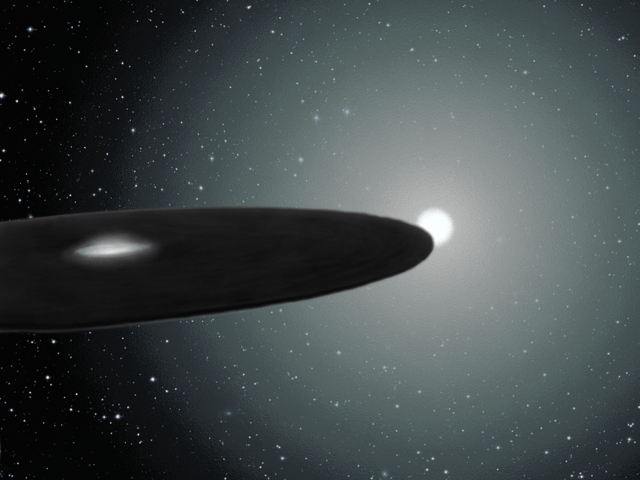Now that the Moon is absent from the early evening picture, are you ready to journey around a black hole? It’s not an easy observation, but it is one that doesn’t require highly specialized equipment and its not difficult to find. Can you identify Capella? Then let’s rock…
Using the map below to help you identify the constellation of Auriga, you won’t have any problem picking out the sixth brightest star in the northern hemisphere night – bright, yellowish-white Capella. While Alpa Aurigae is an interested spectroscopic binary star, it’s not our target. If your skies are fairly dark, look a few fingerwidths southwest for much dimmer Epsilon (the backward 3 on our map). Epsilon Aurigae is an eclipsing binary star, but one that has an extraordinarily long period -27.1 years. While it only drops .8 of a magnitude, it’s dark companion is a 10-12 solar mass black hole. According to studies done by Wilson and Cameron a ring of obscuring material surrounds the black hole and accounts for the magnitude drop. And it’s dropping now!
According to AAVSO Special Notice #192 prepared by Aaron Price: “Epsilon Aurigae continues to progress through its first eclipse since 1982-84. Visual and photometric observation means place it at around magnitude 3.7-3.8. Totality was likely reached sometime in January, but it will take some time to analyze the data to establish a specific date. Totality is expected to last about 15 months, but the system is not expected to remain quiet during this time. Small amplitude modulations are being detected which are likely not associated with the eclipse itself. However, their exact source is still debated. The amplitude of these modulations are at the limit of the average observer’s ability to detect visually. Therefore this may make a nice, challenging system to test your eyes. Right now, Epsilon Aurigae is well placed for observing high in the sky right after dusk.
In addition to these modulations, a mid-eclipse brightening of a few tenths of a magnitude have been reported in past eclipses. If confirmed, it would contribute significantly to our understanding of the structure of the eclipsing disk of material. The problem is this will happen next summer when epsilon Aurigae is near solar conjunction. So observations very early in the morning later this season will be very important. It may be a good idea to begin practicing twilight observations right now.”
What will it look like? Just a barely perceptible change in brightness, but observers interested in DSLR or photoelectric photometers may want to use this project as an entry point. A team of observers is working on a series of tutorials on the Citizen Sky web site. General information regarding the Epsilon Aurigae campaign and a series of online discussion forums can be found at the Citizen Sky web site. Information is also available to submit your observations to the American Association of Variable Star Observers (AAVSO), too!
Journey around a black hole… If you dare!
Epsilon Aurigae illustration is courtesy of Nico Camargo.



Cool!
Epsilon Aurigae is a black hole? WoW! Joe Haldeman was right
It has a black hole for a companion. The disk around the black hole occludes the main star. It is an interesting system. I wish it were closer so we could get a better look at the physics of the black hole.
LC
This was the theory in 1971. But nowadays, not so much.
One of the long-running suggestions for how to achieve a high mass, low luminosity companion would be a small black hole – but new observations have practically eliminated it from consideration.
Observations have been undertaken with X-ray and Gamma ray telescopes in order to confirm Cameron’s hypotheses, but have turned up no evidence for the existence of a black hole in the eps Aur system.
I looked at the spectro data back then, and all of it was rather heavy elements with “absorption” lines, and not emission lines, as you would expect from a binary pair eclipsing the primary. Pretty much why I dropped out of this Citizen Sky project.
I’m a bit late here, but better late than never…
At the first paragraph, in the third line:
That should be it’s (it is), not “its”.
Whereas at the second paragraph, in the seventh line:
That should be an its (possessive form of the pronoun it), not “it’s”.
I’ll now get my coat and see myself out…
Maybe its a Dyson sphere.